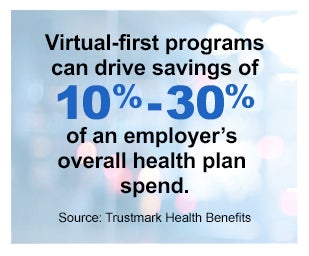

3 Takeaways from the Rise of Virtual-First Health Plans

COVID-19 led many consumers to rely on virtual care as their initial access point to primary care. And while hospitals, health systems and disruptors to the field were busy scaling virtual care services to meet demand, health plans went into action on a parallel front.
Payers and self-insured employers, who cover more than 100 million Americans, have been rapidly developing so-called “virtual-first” health plans. These evolving programs lack a universal definition, but share some common traits, including:
- Emphasizing primary care services with virtual care as the initial point of contact.
- Deploying informatics based on claims data and other sources to deliver actionable insights to plans on utilization.
- Providing active care coordination with concierge-style support to help guide patients to the most appropriate setting and low-cost, high-quality providers (excluding hospital-based physicians from the process).
- Employing clinically integrated health coaches to help patients take ownership of their health goals and achieve them.
Rethinking Cost, Value and Risk
These plans are growing in number, with health insurers like Humana, UnitedHealthcare and Oscar launching virtual-first plans. Many self-funded employer health plans also are embracing virtual-first plans. The reason is simple, says Paul Scaglione, chief growth officer, with Trustmark Health Benefits.
Self-insured employers can’t sustain the average 6% annual health plan cost increase they have been seeing and need to find ways to better engage employees and providers in ways to deliver low-cost, high-quality care, Scaglione noted in a recent webinar with the health innovation incubator Matter.
 Trustmark believes that depending on the plan design, virtual-first programs can drive savings of between 10% and 30% of an employer’s overall health plan spend. The company recently entered into a partnership with Teladoc Health to launch a virtual-first health plan called myVirtualCare Access, which is built around Teladoc’s primary care offering, Primary360.
Trustmark believes that depending on the plan design, virtual-first programs can drive savings of between 10% and 30% of an employer’s overall health plan spend. The company recently entered into a partnership with Teladoc Health to launch a virtual-first health plan called myVirtualCare Access, which is built around Teladoc’s primary care offering, Primary360.
The Move to a Hybrid Ecosystem
About 15% of midsize or large employers with self-funded health plans will offer a virtual-first option in the coming year and another 20% are considering adding a plan soon, Rob Bressler, senior vice president and general manager of primary care at Teladoc, said during the webinar. He believes the market is rapidly headed toward a hybrid primary care ecosystem.
No stand-alone bricks-and-mortar or virtual-only model will be truly successful, Bressler noted in the Matter webinar. A hybrid ecosystem must be created to provide beneficiaries with a seamless, frictionless way to access care between the two touchpoints. Ultimately, he believes, all players will need a well-designed digital front door to get patients to the care they need.
This requires resources and cooperation from all sides to integrate the many digital health care tools in use — from e-triage to telebehavioral health to e-prescribing, etc. — and to explore data-sharing possibilities among partners. Likewise, artificial intelligence and natural language processing programs could play significant roles in generating insights.
Primary care physicians and their teams will play a critical role in this transition, Janet Faircloth, senior vice president of Aon’s health innovation team, noted in the webinar. Patients are most likely to follow the advice of their physicians and care teams, and strategies will need to be developed to include them in guiding patients to the front door to care, she said.
3 Takeaways For Hospital-Based Providers
1. Evaluate whether to provide a digital-first offering.
Explore how you fit in the new referral pattern. How easy is it for online users to navigate your front door and quickly get where they want to go? User experience will be critically important as health plans continue to evolve and beneficiaries take a larger role in managing their health care costs and deciding when to choose virtual vs. in-person visits.
2. Explore partnerships.
The number of virtual care disruptors has exploded from just a handful several years ago to several hundred today. Employers are having a difficult time evaluating such a large number of players and want to establish relationships with the highest-quality caregivers who deliver the greatest value.
3. Focus on diversity, equity and inclusion (DEI).
Surveys show this has become a priority for most CEOs, Faircloth notes, and they want to ensure that their benefits programs and the providers with whom they partner can further their DEI goals. The challenge is that many vulnerable communities do not have access to digital technologies.



